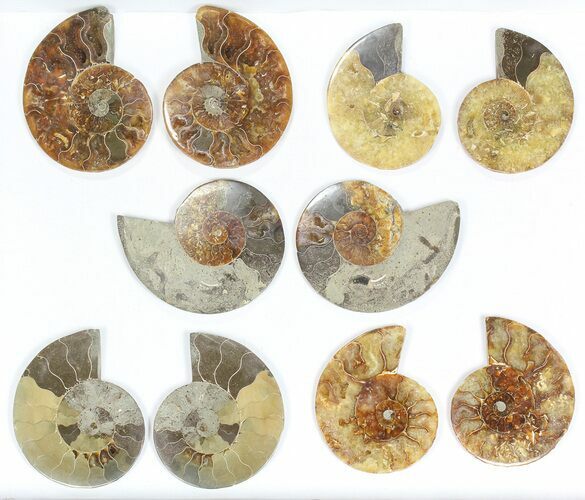This Specimen has been sold.
Lot: 3 1/2 - 4" Cut Ammonite Pairs (Grade C) - 10 Pairs
This is a wholesale lot of cut and polished Cleoniceras ammonite fossils from the Mahajanga Province of Madagascar. They are Early Cretaceous (Albian Stage) in age, or approximately 110 million years old.
The lot includes 10 ammonites with both halves included. They range from 3.4 to 4.2" wide and the entire lot weighs about 4 1/2 lbs. They are grade C specimens meaning many of the chambers visible in the interior's of the ammonite are not well defined or had been filled with mud prior to fossilization. The exterior of the ammonites are attractive with a mix of some showing iridescent shell preservation and others polished to show the "oak leaf" suture pattern underneath the shell.
At the wholesale price each ammonite (both halves) is $7.50 each and they can easily retail for several times that amount.
The lot includes 10 ammonites with both halves included. They range from 3.4 to 4.2" wide and the entire lot weighs about 4 1/2 lbs. They are grade C specimens meaning many of the chambers visible in the interior's of the ammonite are not well defined or had been filled with mud prior to fossilization. The exterior of the ammonites are attractive with a mix of some showing iridescent shell preservation and others polished to show the "oak leaf" suture pattern underneath the shell.
At the wholesale price each ammonite (both halves) is $7.50 each and they can easily retail for several times that amount.
About Ammonites
Ammonites were ancient marine cephalopods, similar to today's squids and octopuses, but with a defining feature: their distinctive, tightly coiled spiral shells. These shells, resembling those of modern nautiluses, served as both a protective home and a buoyancy aid, allowing ammonites to navigate the prehistoric seas with ease. First emerging around 240 million years ago in the Triassic Period, ammonites thrived for over 175 million years, adapting through numerous forms and sizes. As predatory creatures, they likely fed on smaller marine organisms, using their tentacles to capture prey. However, their long reign came to an end 65 million years ago at the close of the Cretaceous, coinciding with the mass extinction event that also eliminated the dinosaurs.
Ammonites were ancient marine cephalopods, similar to today's squids and octopuses, but with a defining feature: their distinctive, tightly coiled spiral shells. These shells, resembling those of modern nautiluses, served as both a protective home and a buoyancy aid, allowing ammonites to navigate the prehistoric seas with ease. First emerging around 240 million years ago in the Triassic Period, ammonites thrived for over 175 million years, adapting through numerous forms and sizes. As predatory creatures, they likely fed on smaller marine organisms, using their tentacles to capture prey. However, their long reign came to an end 65 million years ago at the close of the Cretaceous, coinciding with the mass extinction event that also eliminated the dinosaurs.
SPECIES
Cleoniceras
LOCATION
Ambatolafia, Mahajanga Province, Madagascar
SIZE
3.4 to 4.2" wide (each half)
CATEGORY
ITEM
#77102
We guarantee the authenticity of all of our specimens.
 Reviews
Reviews













